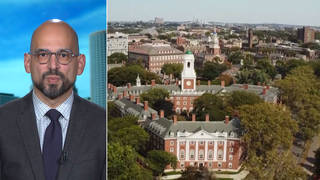
Guests
- Tia LessinDirector and producer of Trouble the Water. She also produced Michael Moore’s Fahrenheit 9/11 and Bowling for Columbine.
- Carl DealDirector and producer of Trouble the Water. He also produced Michael Moore’s Fahrenheit 9/11 and Bowling for Columbine.
Links
As the third anniversary of Hurricane Katrina approaches, we speak with the makers of a new film that takes an inside look at the disaster and the many forms of devastation that followed. Trouble the Water follows a couple from New Orleans’ Ninth Ward and their return home two weeks after the hurricane. It begins with footage shot by the couple, who documented the approach of the hurricane and the moment the floodwaters began to rise. [includes rush transcript]
Transcript
JUAN GONZALEZ: Next week marks the third anniversary of Hurricane Katrina. President Bush visited New Orleans Wednesday and lauded the recovery of the city, saying “hope is marching in.”
But that isn’t quite as clear to many of the city’s residents who are still unable to find jobs or afford housing. In a report to be released Tuesday, Oxfam America details how much more needs to be done to bring back hope to the city, noting that 35,000 people are still living in FEMA trailers and only 12 percent of returning African American evacuees can find jobs.
AMY GOODMAN: Today, we’re joined by the makers of a film that takes us back three years, back inside the hurricane and the many forms of devastation that followed. Trouble the Water is the name of the film. It follows a couple from New Orleans’ Ninth Ward, aspiring rap musician Kimberly Rivers Roberts and her husband Scott Roberts, their return home two weeks after the hurricane. But it begins with footage shot by the couple, who documented the approach of the hurricane and the moment the floodwaters began to rise. This is an excerpt from the trailer of the film.
SCOTT MICHAEL ROBERTS: My name is Scott Michael Roberts. This is my wife Kimberly Roberts.
KIMBERLY RIVERS ROBERTS: New Orleans.
SCOTT MICHAEL ROBERTS: We’re from New Orleans, the Ninth Ward, underwater.
They said on the news that it’s like aiming toward Mississippi, so we might get the [inaudible].
KIMBERLY RIVERS ROBERTS: There’s the sky. It looks pretty now, but it sure soon will change.
SCOTT MICHAEL ROBERTS: I hear some thunder.
KIMBERLY RIVERS ROBERTS: Golly! Look at that water, boy! Ooh, Lord!
SCOTT MICHAEL ROBERTS: You see how high that is?
KIMBERLY RIVERS ROBERTS: Holy Jesus!
Ooh, be with us, Lord, please.
All this water, coming through the windows.
Hey! Help us get off the roof, man! You’re a real hero, boy!
We under siege, truly under siege. Everybody done lost everything around here.
Now, you have seen, ’cause Katrina has done this. She has stuck us in the attic. I’m running out of juice, too.
These houses have not been inspected yet. There could be dead people right now, as we speak, because the National Guard, they have not been here, and it’s two weeks after the hurricane.
SCOTT MICHAEL ROBERTS: This is one of the Navy bases that Bush had planned to close down.
Why can’t we stay overnight? What about the women and children? They said, “Get off our property, or we’re going to start shooting.”
AMY GOODMAN: The trailer for Trouble the Water. It won the Grand Jury Prize at Sundance Festival this year. Opening night tonight, here in New York at the IFC theater. It’s opening in Los Angeles, as well, being released with a national rollout in September.
We’re joined now by the film’s co-directors and co-producers, Tia Lessin and Carl Deal. They also produced Michael Moore’s Fahrenheit 9/11 and Bowling for Columbine.
Welcome to Democracy Now! What an astounding film! What an astounding woman, that she got the camera — when did she get it?
TIA LESSIN: She had bought a camera on the street about a week before the storm. She wasn’t intending to chase the storm. She wasn’t — you know, she bought it for — it was a good value, and she was looking to tape family events and birthday parties. It so happened that, you know, when Katrina hit, she and about 100,000 others weren’t able to leave the city, because they had no public transportation, no means to get out, and the city hadn’t provided for their evacuation.
AMY GOODMAN: How did you find Kimberly?
TIA LESSIN: We were — Carl and I went to central Louisiana about ten days after the storm. You know, Bush, two days ago, was commending the Louisiana National Guardsmen for their work rescuing — well, they were actually in Iraq at the time of the storm. And Carl and I went down to central Louisiana to tape their homecomings about ten days after the storm. And at one point, the National Guard shut us down, because we had found out that the high-water vehicles were in Iraq, along with the National Guard, and they didn’t like the questions we were asking. Carl wandered over to the Red Cross shelter, and Kimberly wandered right up into our frame and started to tell her story on camera.
JUAN GONZALEZ: And then you decided to follow her in her efforts, as well?
CARL DEAL: Yeah. Well, look, when we met Kimberly and Scott, it was —- they had just come out of hell, right? And they presented themselves with incredible optimism at the same time and invited us along to see what was going to happen next with their lives. We didn’t know where this story was going to go.
AMY GOODMAN: This is a part of the film that was shot by Kimberly Roberts.
KIMBERLY RIVERS ROBERTS: Holy Jesus! This is my face after just opening my back door.
Ooh, be with us, Lord, please.
Man, I’m talking about n—— going to take a dip if they want.
We’re going to plan B. And plan B is, we about to start stacking our furniture to try to get up to the roof.
AMY GOODMAN: This is astounding footage. I mean, when she first meets you, she said, “I’ve got stuff that I haven’t seen anywhere.”
TIA LESSIN: It’s extraordinary. It’s extraordinary. And, Amy, you did some of the very best reporting on the Gulf Coast at the time of Katrina. But the rest of the media was showing you the outside looking in, and Kimberly’s footage gives us an opportunity to see what happened from the inside looking out.
AMY GOODMAN: You go beyond the hurricane, and you follow them in this journey afterwards in seeking help. You have an amazing scene, where Sam —- where Kimberly’s husband -—
TIA LESSIN: Scott.
CARL DEAL: Scott.
AMY GOODMAN: Scott. Where describes going to the naval yard? Can you explain what happened?
CARL DEAL: Yeah. There’s a —- well, there’s a naval support activity building in the Ninth Ward. A lot of people don’t know that. It was the only building in New Orleans that actually had power in the days after Katrina. There was one light up there. You had the light of the moon and the stars, then you had the light at the naval base. And after their second day of no rescue coming, Kimberly and Scott led a group of several hundred people to the naval base, right up to the gate, and they knew they had empty rooms there. It turns out it’s kind of a barracks. And they were turned away -—
AMY GOODMAN: Hundreds of rooms!
TIA LESSIN: 500.
CARL DEAL: Hundreds of rooms, hundreds of rooms. And they were turned away at gunpoint. And later, we went back and spoke with some of the sailors who were at the base and the CO, and they said, “We were just doing our job, which is protecting the interests of the US government.” Somehow, the interest of the US government isn’t looking out for the best interests of its own citizens.
JUAN GONZALEZ: And this is one aspect of the catastrophe that never got any coverage, as far as I can recall, of citizens being turned away at that barracks.
CARL DEAL: You know, we’ve heard the story from a dozen people, you know, who were there, eyewitnesses, and it hasn’t been reported elsewhere.
TIA LESSIN: You’ve got to see it in the movie in order to see it.
AMY GOODMAN: We want to have you back next week at the Democratic convention. Why are you going there?
TIA LESSIN: You know, we’ve been invited to show the film to the Democratic National Convention and to the Republican National Convention delegates. It is an important film, as we lead up into the election. We need to remind, you know, the delegates that Katrina — people are still struggling, that Katrina existed before the storm, that Kimberly and Scott have weathered many storms in their lives, and they are eager to tell the delegates about that.
AMY GOODMAN: So you’re showing it to the delegates on Wednesday across from the convention center?
TIA LESSIN: That’s right.
AMY GOODMAN: We hope to have you on with Kimberly and Scott again next week. I hope we can.
TIA LESSIN: Wonderful.
AMY GOODMAN: But that wraps up this section of the show. The film opens tonight in Los Angeles and in New York. Tia Lessin and Carl Deal are the co-directors and producers of Trouble the Water, remarkable film, that it is.













Media Options